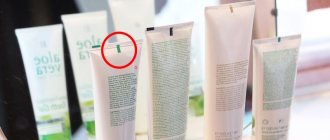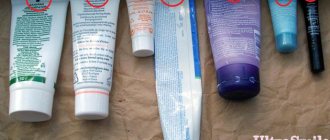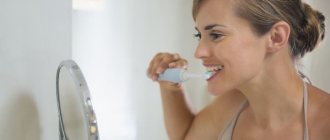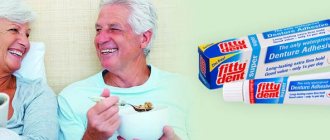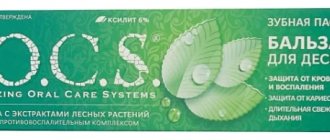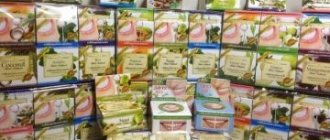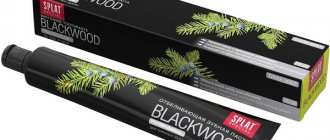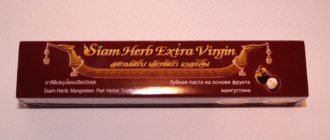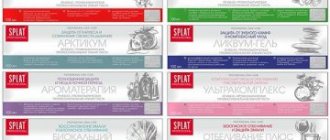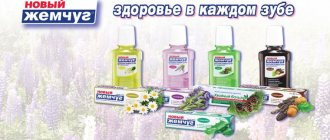Share
Tell
Share
Tweet
Share
Have you ever noticed the multi-colored stripes on tubes of creams, toothpastes, shampoos and other care products? Some people believe that the color of this rectangle indicates what the product is made of. Like, if it is black, then the cosmetics consists of 100% chemicals, and if it is green, then these are natural ingredients and an eco-product. This funny misunderstanding has been widely circulated on the Internet, so many continue to believe that the color of this stripe really means something. It's time to destroy this myth.
What do the colored stripes mean on tubes of toothpastes and creams?
There are so many different myths about what the colored stripes on toothpaste tubes mean. Allegedly, they are talking about harmful substances, the permitted frequency of using the paste, and what country or city it was actually made in. The most advanced manufacturers began to produce toothpastes in tubes with a green stripe, supporting the myth of their naturalness. But in fact, such assumptions are wrong, and any dentist can confirm this.
How to dilute dry food coloring for cream?
Dry (powder): so, in order to color the cream with it, you should first dilute such food coloring in water, alcohol or vodka.
Interesting materials:
In what climate zone is the tundra located? What month is best to go to Tanzania? In what month can you conceive a girl? In what month should you plant tomatoes and cucumbers? In what month does the Kolkhoznitsa Melon ripen? Where should you pet a cat? Where to stop before a traffic light? In which museum is the pectoral located? In which ocean are the Seychelles Islands located? Which ocean has the warmest and saltiest sea?
Basic myths about color marks on tubes
According to some consumers, the colors of the stripes on tubes of toothpastes, ointments and creams indicate the characteristics of their composition:
- Red is about synthetic.
- Green is about the environment.
- Blue and brown indicate that the product is half natural.
- Black - contains only chemical components.
Another part of consumers is of the opinion that colored markers indicate the degree of abrasiveness, the presence of protective properties, or the cost of hygiene products.
| Color of the strip on the paste tube | Number of abrasive particles | Protective properties | Price |
| Red | Few | Although it contains synthetic components, it provides the required degree of enamel protection. | Expensive product |
| Green | No | Effectively protects teeth and oral cavity from diseases thanks to its ecological composition | average cost |
| Blue, black, brown | A lot of | Has a low degree of protection, provokes periodontal disease | Cheap remedy |
How to choose a natural product?
When choosing pasta for your family, be very careful and demanding. The fact is that every time a cleaning product is used, its components enter the oral mucosa and, accordingly, are sent into the bloodstream, so the quality of the paste and the safety of its ingredients greatly affect health.
To correctly select the safest toothpaste, we will conduct a comparative analysis of several products from well-known brands, such as: Blendamed, Sensodyne, Aquafresh, etc. We will compare pastes without analyzing them in detail into all their components, but paying attention only to the presence of only three components in them: parabens, SLS and propylene glycol.
| Trademark | Parabens | SLS | Propylene glycol |
| Blendamed | — | + | — |
| ROCS | + | — | — |
| SPLAT | + | + | + |
| Sensodyne | + | — | — |
| Aquafresh | — | + | — |
| President | — | + | + |
| LACALUT | — | + | + |
| Forest balm | + | + | + |
| Siberian Health | — | — | — |
INTERESTING: Lacalut Aktiv toothpaste: instructions and composition, photo
All three substances are contained in SPLAT and Forest Balsam pastes. ROCS and Sensodyne contain parabens, Aquafresh contains the SLS component, President and LACALUT contain propylene glycol and SLS, but none of these substances are present in the Siberian Health paste. Therefore, Siberian Health is the safest and most natural.
GOST and multi-colored stripes
A modern tube of toothpaste made in Russia must comply with three GOST standards at once:
- GOST 7983-99 (based on ISO 11609-95) talks about the correct marking of a paste mass and what it means.
- GOST 14192 and 28303 indicate the requirements for containers.
These documents state that:
- It must be indicated on the tube:
- Product name;
- brand;
- trademark;
- volume;
- compound;
- acceptable storage conditions;
- best before date;
- availability of relevant certificates.
- The marking is applied in the language of the manufacturer and the importing country.
- Permissible deviations from weight are 5%.
- Containing materials must be environmentally friendly.
But none of the GOSTs talks about the meaning of colored stripes on toothpaste and the rules for applying them. That is, the state does not regulate in any way the procedure for applying a “color barcode” ; the company itself decides the issue of marking toothpaste with colored stripes and can do without these designations.
What other marks are often found on cosmetic products?
There are a lot of labels for cosmetic product packaging. Some are mandatory for all manufacturers in the Customs Union, others are used only by one company for marketing purposes.
Article on the topic
Take a break. What you need to know about deodorants and antiperspirants
As Elena Moskvicheva points out, you can often find a sign on tubes of cosmetics in the form of an open jar, inside of which there is a number and the letter “M”. This symbol indicates the expiration date of the product from the moment it is opened, that is, the time within which the manufacturer recommends using it. If the standard shelf life of many sealed cosmetics is usually 24-36 months, then the shelf life of open ones is much shorter - often 6-12 months.
Another interesting sign is an open book with a finger pointing at it. This mark means that the package is too small and all the necessary information does not fit on it. As a rule, such cosmetics are sold in secondary packaging (for example, cardboard boxes), into which a leaflet with complete information about the product is inserted.
Moskvicheva especially highlights the signs that companies use to declare that their cosmetics are organic. In different countries, and even in the same country, these labels may differ among different manufacturers. According to the expert, the professional community has not yet reached a consensus on which cosmetics are considered organic. “Each company that produces such cosmetics has its own criteria. Other companies do not support them [criteria]. That is, most often this is just a marketing mark,” the analyst noted.
Why are multi-colored stripes applied?
In fact, the colored stripes on the tubes are an identification mark for the conveyor during automated production. They are necessary for high-quality separation of the tube blank from the conveyor belt.
Stripes on pastes
The technological sensor detects the color marking and cuts off the future tube of toothpaste. After this, the plastic sheet is twisted, glued and filled with gel content. After these manipulations, the tube is finally glued and closed with a cap.
The color of the mark on toothpaste, by and large, means nothing. The manufacturer can independently choose the range and height of the strips, regardless of the chemical composition of the product and the shape of the container.
Streaks on creams
Creams are marked as the products move along the conveyor belt in a non-contact manner using special color markers read by conveyor sensors. They allow you not only to correctly cut and solder the tube, but also indicate places for applying drawings and text on the container.
Information about the composition and manufacturer is applied by inkjet using special ink. That is, red, black and other stripes are needed only in the process of producing creams using robotic technology.
Are all pastes color coded?
We'll tell you a secret - stripes are found not only on toothpaste, but also on any tube that contains creams, gels or any other cosmetic products. And these marking stripes can be of completely different colors (red, green, blue, black) and even shapes (square, rectangular), but are invariably localized on the tail of the tube.
Stripes are found not only on toothpaste, but also on other tubes
Naturally, most consumers have a question - what can color markings mean? Maybe she reveals to us secret information or an important message that will warn us against buying or, conversely, tell us about the miraculous properties of this product? Let's figure it out together.
The True Meaning of Flowers
Despite the simple explanation for the appearance of stripes on toothpaste tubes, a certain color is chosen for a reason. The choice of mark shade is influenced by:
- Tube color. A black (dark) stripe on the toothpaste means that the main tone of the blank and tube is white or just a light shade. Light marks are typical for dark-colored containers, but manufacturers who decide to choose this shade of marker take a risk, since the photo sensor may not “catch” it during the soldering process.
- Limited choice. Typically, the marking involves 4 basic shades (CMYK - Cyan Magenta Yellow Black). Additionally, a fifth color can be used to print a barcode, text, or one light mark.
That is, the correct reading of the marking by the optical sensor depends on the contrast of the stripe and the main color of the tube.
Most often, the tags are darker than the background, which allows the sensors to read the necessary information most efficiently. When choosing a marker shade, packaging design is no less important. This means that if there are blue elements on a tube of toothpaste, then the stripe on it will be blue. Since the stripes on tubes of creams and pastes do not mean anything important (impact on the enamel), they can easily be replaced by other design elements at the discretion of the manufacturer.
Technological photo marks can be divided into 2 types based on their position on the sheet:
- horizontal markers are placed for precise cutting of the main workpiece when printing on a rolled laminate;
- vertical marks are needed to accurately indicate the location of the cut when soldering the tube, so that it is parallel to the main text and image on the final product.
Myth No. 2: color indicates the ratio of chemicals and natural substances in the composition
There are other ridiculous interpretations of what the colored stripes on toothpastes mean. For example, color can indicate the percentage of chemicals in the product:
- black: the product consists entirely of chemical components, i.e. 100%
- blue: there is a little less chemistry here, about 80%,
- red: semi-natural-semi-chemical composition, i.e. 50/50,
- Green: This is a 100% natural, organic and safe product. It supposedly contains only herbs and oils.
“My grandmother heard from a friend about what the stripes on toothpaste and other products mean. Afterwards, she carefully inspected her bathroom and found, oh my God, a package with a black mark. It was panic. It took a long time to prove to my grandmother with the whole family that all this was nonsense and give examples: they took shoe polish - there was a green mark on it, was it natural? But the tube with baby cream turned out to have a black mark! It turns out that they are harming children and not even hiding it? The manufacturer has become insolent! We took condensed milk in soft packaging from the refrigerator, and there was a black mark there. Yes, all packages have these marks. In general, they somehow convinced me that everything was fine and there was no catastrophe...”
Larisa, fragment of a review from correspondence on woman.ru
Labeling procedure
Color division depends on the equipment and the number of coloring sections. At the preparatory stage, one main color is taken, which will contrast most with the color of the tube. Based on it, the features of reading elements and printing a barcode are determined.
If you use two colors at once, for example, blue and black, this will lead to unreadable text when the equipment is moved. Optical sensors correctly capture one primary color (red, green). Most often, white color is used for the background, since all the colored stripes are clearly visible on white tubes; the height and width of the marks are discussed individually. This approach allows us to minimize the costs of producing and placing information on tubes using a printed, non-contact method.
But the color of the marking has nothing to do with the composition of the gel. Typically, the tubes are manufactured by a company that has nothing to do with the development of the personal care product itself and dentistry, so its labels simply by definition cannot refer to the chemical composition of the paste-like mass. If stripes on toothpaste mean anything, it clearly doesn't matter to the end consumer.
Depending on the required parameters of the tube, a large blank sheet is divided into parts of a certain size. Light marks are placed as delimiters. They indicate the location of the incision to produce a tube of the required volume. Different colors of markers help identify manufacturing defects and other technological defects.
The stripes on toothpaste do not mean anything, so you don’t need to look closely at them and look for a secret sign in them. If you need to choose a paste with some specific indicators, you should look for information about them not in strips. The content of synthetic and natural substances in the gel can be found by reading the composition information posted on the tube.
Myth #3: The color will tell you how often you can apply the paste.
Some “experts” on this issue also claim that stripes on toothpaste tubes indicate the presence or absence of abrasives in it and how long such a product can be used:
- black stripe on a tube of toothpaste: it’s all abrasives that will help effectively whiten enamel, as well as remove and prevent the formation of hard deposits and stone. However, you cannot use this composition for a long time; it is better to use it 1-2 times a week and no longer than a month, otherwise there is a risk of damaging the integrity of the enamel and making it very sensitive. It should also not be used by children
It is a misconception that a paste with black marks will dissolve tartar. - red and blue stripes on toothpaste: some Internet users claim that it contains much less abrasives than black, which is why you can use it more often - 2-3 times a week. However, if there are problems with the gums (for example, inflammation, sensitivity), then it is better to stop using the composition and use other types. For example, the “Forest Balm” series, which helps to cope with the manifestations of the inflammatory process on the mucous membrane.
- green: this is a herbal medicine that will not cause harm to enamel and gums even with daily use. This remedy can be used for long weeks and months on end. By the way, as some particularly “vigilant” Internet users claim, a number of manufacturers use the green label to deceive the buyer and pass off the chemical composition as a natural product.
Do not think that all pastes with green labels consist of 100% natural ingredients
Looking for a truly natural oral care product? Read the article on the topic: TOP 7 natural toothpastes from the ECO series.
Squares on tubes: what do they mean?
myths circulating on the World Wide Web regarding labels on cosmetic products . The most common of them gives the following interpretation of the rectangles on the packaging:
- Black or other dark shades - the product is replete with substances harmful to health. The daily use of such “chemicals” can pose a danger to human health;
- The blue color of the square indicates a slight decrease in the concentration of synthetic components relative to the previous category. The share of natural “ingredients” reaches 1/5;
- The red square serves as a signal that the proportion of natural substances is exactly half per 100 grams of substance;
- The green color of the brand indicates that the product can be safely classified as “Organic”. The composition includes only natural raw materials, which have only a beneficial effect on health.
Beautiful nail design with stripes
Fantasy stripes created using cobweb gel look seductive and unusual. An ideal combination with colored, nude plates. Create geometric patterns in stripes, duplicating some of them with glitter or filling the space created in the design with different colors. Try narrow stripes of different colors in combination, for example, with circles (photo 1).
Alternative theory
mythological meaning is sometimes attributed to flowers on toothpaste :
- Black: composition for whitening tooth enamel. Recommended for use no more than once a week;
- Blue: the mass is suitable for everyday use;
- Red: there is a healing effect. Such products are sold in pharmacies and prescribed by dentists in case of painful teeth;
- Green: designed to consolidate the healing results achieved by the previous composition. Recommended for use within 4 weeks after the treatment course.
Other decryption options are also possible. The gradation of colors is often interpreted as a distribution by price categories of goods, where the green marker is an indicator of an elite and expensive “eco-product”.
Myth No. 1: a color marker signals the harm or benefit of the composition
- green: this is a natural product that contains environmentally friendly ingredients,
- what does the red stripe on toothpaste mean: such products are full of ingredients and substances that are dangerous to the health of the body and oral cavity,
- blue: the product contains synthetic substances, but they are not dangerous to health or life, because their use in a certain ratio is permitted,
- what does a black stripe on toothpaste mean: such a product is very dangerous, and it may also contain substances that provoke gum inflammation, gingivitis, periodontitis and periodontal disease.
There are myths that the strips symbolize the dangers and benefits of the product
Features of container production
Before answering the question regarding the true meaning of squares on containers, you need to provide information about the features of their production.
Creating regular tubes looks like this:
- The polymer blank is cut into pieces of a certain length and width;
- The logo, barcode, manufacturer data and other information are applied to the tube;
- Rolling up a segment that takes the shape of a cylinder;
- Sealing the edges of the sample (on one side);
- Filling the container with cream (or other substance);
- Clogging and sealing of the cylinder;
- The date of manufacture and expiration date are printed on the seam. light mark” is also affixed , thanks to which the machine recognizes the exact location where the cut needs to be made.
The specified sequence of actions is applicable to the process of manufacturing plastic products. The mechanism for creating aluminum tubes is somewhat different, but the placement of a color marker also takes place.
Manicure with gold stripes
Sometimes they alone are enough to create an expressive coating. A bright and dramatic option - gold on a scarlet plate. Noble color scheme - gold on deep blue or green. On yellow it will look like a celebration of life, slightly flavored with elegance. Like other stripes, gold stripes can be vertical, diagonal, or horizontal.
What do the stripes on tubes of creams mean?
We found out that there is nothing supernatural hidden behind the mysterious rectangles on the containers of cosmetic and hygiene products:
- The light mark can be any color. The main requirement for it is readability for the machine. Therefore, you need to paint the rectangle so that it is as recognizable as possible for the car and contrasts sharply against the background of the overall design of the product;
- Horizontal figures indicate the cut line, vertical ones are used as a marker for the sealing location;
- Sometimes light marks may be completely absent from the container: instead, figures disguised as design elements are used;
- International standards do not have any requirements regarding seam markers. The ISO 11609-95 standard, which describes the technology for the production of dentifrices, does not contain data on light markers.
French manicure with stripes
The simplest thing you can do is duplicate the smile stripe. But if the smile itself is wide enough, then it is also painted with stripes to suit the mood.
Quality assessment criteria
A high-quality toothpaste should not contain the following substances:
- Sodium dodecyl sulfate - used to form foam. It is inexpensive, so it can be found in products in the low price segment. It has a negative effect on the skin of the oral cavity, is one of the causes of early baldness, and can reduce visual acuity. It tends to accumulate in the body, so daily use of such substances is not recommended;
- Triclosan is designed to destroy and inhibit the growth of pathogenic bacteria. Along the way, it destroys a number of microorganisms necessary for health;
- Fluoride helps in the prevention of caries and other dental ailments, but is quite poisonous. If large quantities of fluoride or fluorides are accidentally ingested, poisoning may occur;
- The controlled abrasiveness index should be within 100 for healthy teeth.
On the Internet you can find a wide variety of explanations of what the stripes on toothpaste tubes mean. Allegedly, they indicate the degree of environmental friendliness or the price category of the product. But in fact, their purpose is exclusively practical and makes sense only for a machine on a conveyor belt .
Video: codes on tubes
In this video, Igor Mulatov will tell you how manufacturers label toothpaste tubes and what the green and blue squares on the packaging mean:
List of dangerous components
The presence of these ingredients in the composition indicates a risk to your health:
- parabens (ethylparaben, methylparaben, butylparaben) - substances that tend to accumulate in the body and cause cancer,
- SLS (sodium lauryl sulfate) - can irritate the oral mucosa, promote bleeding gums and hypersensitivity of teeth,
- propylene glycol - can cause irreparable damage to the liver and kidneys, causing cancer.
Although these substances are negligible in modern toothpastes, is it worth the risk when there are a huge number of safe, natural alternative products. In addition to the components used in the analysis, there are a number of dangerous substances, the presence of which makes you think about the advisability of choosing a toothpaste containing them.
Beware if the paste contains:
- SCS - sodium cocosulfate, essentially the same substance as lauryl sulfate,
- glycenophosphate - used as a strengthening agent for tooth enamel and caries prevention, but in large quantities it leads to the opposite effect,
- triclosan is an ordinary antibiotic whose task is to destroy harmful bacteria in the oral cavity, but along with them the product also kills beneficial microflora,
- aluminum lactate - designed to relieve inflammatory processes and prevent bleeding gums, at the same time reduces the sensitivity of tooth enamel to extreme temperatures, which causes teeth to suffer,
- sodium CMC - stabilizer of toothpaste consistency, causes allergic reactions,
- sodium saccharin is an artificial sweetener that is added to create a pleasant taste, is a carcinogen and is not absorbed by the body at all,
- tanium dioxide - the same teeth whitener that dissolves plaque, accumulating in organs, leads to cancer,
- cocamidopropyl betaine - a substance used to make the paste soapy and rich in foam, a powerful carcinogen that causes pathologies of the liver and thyroid gland,
- sodium lauroyl sarcosinate is a substance that removes dirt and creates rich foam, also used in washing powder, an analogue of lauryl sulfate.
Harmful components of toothpaste not only do not strengthen teeth, but destroy them. At the same time, bones and internal organs suffer, and there is a risk of the formation of cancerous tumors in any part of the body.
We don’t eat paste, we just brush our teeth with it! In fact, when brushing our teeth every day throughout our lives, we swallow more than 2.5 kilograms of the product, and along with it harmful components and carcinogens. You need to be especially careful when choosing a cleaning product for children's teeth. After all, kids love sweet, fragrant, colored toothpaste with the smell of strawberries or bubble gum, and eat it with pleasure when brushing their teeth.
What does the stripe mean on cosmetic tubes?
Varya Valovil
It would seem, “How many times have they told the world…” but no! Here and there, topics that have already been chewed over several times continue to emerge. But our task, as the main organic publication, is to periodically remind who is who, or rather, to tell what is true and what is not.
Active discussions of stripes on tubes began a long time ago, but the peak moment was when Elena Malysheva said in the program “Live Healthy” that this is not just a stripe, but a secret message from cosmetics manufacturers, which no one knows about, but “I, they say, you , fools, now I’ll tell you the truth!”
Here, by the way, is this issue, I suggest you read it:
With the development of blogging and the emergence of a huge number of beauty-health-eco-shmeko blogs, this conspiracy theory has been reborn. After all, nothing motivates people to action like fear. She states that:
" Green - contains 100% natural raw materials, environmentally friendly substances Red - contains both synthetic and natural substances Black - contains substances hazardous to health"
The question immediately arises: where did the blue and white stripes go? Why didn't they say anything about them? I offer my interpretation: the tubes with the blue stripe contain only water! And in tubes with a white stripe there is air. By the way, there is also an opinion that the black stripe indicates the absence of animal testing.
As you can guess from my caustic comments, Elena Malysheva’s statements about green, red and black stripes have no basis. It is clear that my theory about the blue and white stripes is the same.
Let's move on to the serious part of the article: argumentation.
In fact, the stripes are technological markings; they serve to correctly orient the tube in the tube-filling machine. In order for the photo sensor to catch the photo tag, it must be as contrasting as possible with respect to the color of the packaging; this is the only thing that determines the color of this stripe.
There is no connection between the composition of the product and the strips for at least three more reasons:
- The green tube in the first photo in this article is Weleda SkinFood cream, the naturalness of which is confirmed by the international eco-certificate NaTrue, and the strip is “for some reason” black.
- Most aluminum tubes do not have such marks, although they produce creams, toothpastes, and much more. The fact is that aluminum tubes are not soldered, but wrapped, this is done by another machine and the need for a mark disappears.
- The Russian manufacturer of cosmetics “Nevskaya Kosmetika” (Ushasty Nyan, New Pearl, Tip-Top, etc.) posted on its website an official confirmation that the marks on the tubes are nothing more than technological markings. Maybe they produce cosmetics that are not the most environmentally friendly and natural, but there is definitely no doubt about the technological effectiveness of their production.
Apparently, the manufacturer was so tired of letters from frightened people that the marketing director himself was forced to write a paper refuting it.
What actually helps to recognize the naturalness of a product?
- Eco-labels. The most, MOST reliable source of information about the natural composition of the product. The main thing is to be sure that this is a real eco-certificate, and not an ordinary circle with a leaf inside and the inscription “100% organic.” We wrote about them here and here.
- Compound. The ability to recognize critical ingredients in a composition is extremely useful! Here are some articles that will help you figure it out: 1 and 2.
leave a comment
Related Posts
What to drink from in the new decade?
- promo
Rye and flax - a new organic and grain-based store in Reutov
How the unfavorable environmental situation in Russia slows down economic growth
Most popular
Almost no jar of cream, tube of deodorant or hair product is complete without it. Propylene glycol in
Currently reading
The Arkhangelsk Regional Arbitration Court declared the buildings on the site of the future landfill in Shies illegal and demanded their demolition. TO.
LiveInternetLiveInternet
– Quote book
A tablecloth made of beautiful motifs from VKontakte, KNITTING NEEDLEWORK community.
Beautiful long dress made of motifs. A charming long dress (however, it can be...
Pillowcase made of square roses + detailed step-by-step MK. View: https://appleblossomdreams.
Crochet star pattern and what you can crochet with it! We collect a chain of air loops. .
10 books that will help you find the path to your own perfection 1. Karen Pryor &m.
–Tags
–Categories
- CLOTHING (42)
- STATEMENTS OF GREAT PEOPLE (17)
- DESIGN/INTERIOR (15)
- Children's (1)
- Design ideas (12)
- Kitchen/Dining Room (1)
- Bedroom (1)
- HOUSEHOLDING (12)
- HEALTH (30)
- CREATIVE ITEMS (21)
- NATURAL COSMETICS (40)
- Hair (13)
- Soap making (1)
- Face (20)
- Legs (4)
- Hands (6)
- Body (4)
- UTILITIES (13)
- NATURE (7)
- PSYCHOLOGY (56)
- Self-improvement (33)
- THOUGHTS ABOUT LIFE. (12)
- RECIPES (138)
- Baking (31)
- Fish (11)
- Meat (10)
- Side dishes (10)
- Snacks (40)
- Drinks (2)
- Dishes decoration (24)
- Useful tips (8)
- Seasonings (5)
- Salads (8)
- Sweet (22)
- Sauces (5)
- Soups (5)
- HANDCRAFTS (44)
- crochet (24)
- cutting and sewing (7)
- accessories (6)
- for home (5)
- decorations (3)
- knitting (3)
- gifts and souvenirs (2)
- business stuff (1)
- MOVIES (1)
- ESOTERICA (409)
- Astrology (382)
- Vedas (4)
- Rituals and rituals (8)
- Religion (1)
- Tarot (356)
- Feng Shui (1)
- HUMOR (58)
- Adults (3)
- Sayings (13)
- Children (13)
- Animals (32)
- LEGAL ISSUES (3)
–Links
-Music
–Search by diary
–Subscription by e-mail
-Statistics
What do the colored stripes on the tubes mean?
The stripes on the tubes are technological markings. It is needed only for the production of tubes and has nothing to do with the contents of the tube and its composition.
When the machine cuts the tape and rolls the tube, it follows these marks. “Looks” at them with his “eye” - a photocell. And in order for the marking to be better visible, its color is selected from the available set based on the principle of maximum contrast with the background (material) of the tube.
For example, if the tube is white, and the print colors include black, the mark will be black, as it has the most contrast to the background. If there is no black in the color set, another, most contrasting one, will be used.
Why am I writing all this? And so that you look with contemptuous pity at those who, by the color of this label, determine “the degree of environmental friendliness and the percentage of natural composition of the components of the contents of the tube.”
My wife heard this nonsense from the mothers in the yard, and googling showed that people sincerely believe in it. Here is a typical opinion about tubes of toothpaste, taken from the website baby.ru (the first link on Google when searching for stripes on a tube):
return to "Prodkhoz - Food and Economy"
Initially, the design of the future tube is developed. For most “designers” there are only 4 colors - CMYK (Cyan Magenta Yellow Black). But not all of the designers’ ideas can be reproduced when printing in full color, so the design goes to the pre-press department for further processing, where problematic design elements are processed: unnecessary colors are removed, replaced with spot colors, color separations are made in accordance with the number of ink sections of the printing machine and etc. technological aspects.
For example, a design contains an image and text (all done in full color - cmyk). The designer assigned blue color (cyan+magenta) to the text and barcode, because he was told so by higher powers from outer space, or simply this color is in harmony with the general idea of the design, or it is the brand color of the company, etc... Print such elements by superimposing two colors on each other it is impossible, since if the colors are not combined, the text will not be readable, and the barcode will not be readable, therefore, at the pre-press stage, a spot color is assigned to this text, choosing a color from the Pantone catalog (the design will already be made in 5 colors - cmyk + pantone), therefore the photo tag will be blue, and not red or green, since an additional color is an additional expense, which the manufacturer will not agree to, trying to keep costs to a minimum.
Now about technological photo tags. Photo marks are necessary, as mentioned above: - horizontal - for precise cutting of the laminate sheet in height (when printing on a rolled laminate sheet) - vertical - for precise positioning when soldering the tip of the tube (so that the solder is parallel to the image and text part, and not under angle or perpendicular) As a rule, the mark is printed with the same ink, like a barcode.
In order for the photo sensor to catch the photo tag, there needs to be a contrast between the background and the tag. The maximum contrast is a white material and a black photo tag. If the design contains black paint, then both the photo tag and the barcode will be black; if there is no black paint in the design, then the maximum contrast color relative to the background is assigned. If the background is black/dark, then use a white photo tag. There are cases when there are no photo tags at all, and their role is played by design elements. Many manufacturers take a risk by assigning a light color to the photo tag and barcode, since the barcode may simply not be considered a scanner in a store, and the photo sensor may not catch the tag when sealing the tip of the tube. To select the color of tags and barcodes, preliminary tests are carried out, but most often manufacturers do not risk releasing a low-quality product and use black/dark color.
Short striped manicure: popular solutions
Stripes are one of the best design options for short nails. Located longitudinally or diagonally relative to a very wide nail plate, they visually correct it, making it thinner and longer. On narrow, elegant plates of tape and webs, monochrome and multi-colored lines can be applied as your heart desires, achieving an unsurpassed result. In addition, such drawings or foil ribbons look light and airy, without burdening the design with too many elements.
View this post on Instagram
Posted by Unreel (@extremeofficial)
